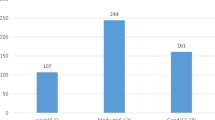Abstract
High blood pressure (HBP) is one of the most important risk factors for morbidity and mortality in the world. Non-adherence to medication is associated with the lack of control of HBP. The objective of this study was to assess the validity of four indirect methods for measuring adherence to medication to control HBP in primary health care. A random sample of 120 hypertensive patients who were undergoing treatment for at least 2 months in a primary care unit in Florianópolis (Brazil) were included in the study. The independent variables were four indirect methods to measure adherence to medication: knowledge regarding the HBP medication, the blood pressure level, attitude regarding the medication intake (Morisky–Green test) and self-reported adherence. The classification of HBP was based on criteria established by the Brazilian Ministry of Health. The gold standard used for measuring adherence was the pill count. Logistic regression was used to estimate sensitivity (highest value of 88.2% for self-report), specificity (highest value of 70.7% for HBP control), positive predictive value (highest value of 46.4% for HBP control) and negative predictive value (highest value of 79.1% for Morisky–Green test) for each of the indirect methods. No indirect method of measuring adherence had a good positive predictive value for adherence, which was best predicted by patients' age and whether they managed to control HBP. The results also revealed low treatment adherence (31.2%) and low control of HBP (37.6%). Non-adherence was mainly associated with side effects of the treatment.
This is a preview of subscription content, access via your institution
Access options
Subscribe to this journal
Receive 12 digital issues and online access to articles
$119.00 per year
only $9.92 per issue
Buy this article
- Purchase on Springer Link
- Instant access to full article PDF
Prices may be subject to local taxes which are calculated during checkout

Similar content being viewed by others
References
WHO. Adherence to Long-Term Therapies: Evidence for Action. World Health Organization: Geneva, 2003.
Pedoe HT . Hypertension. In: Miller DL, Farmer RDT (eds). Epidemiology of Diseases. Blackwell Scientific Publications: London, 1982, pp 122–135.
Braam RL, van Uum SH, Russel FG, Swinkels DW, Thien T . Bromide as a marker to measure adherence to drug therapy. Eur J Clin Pharmacol 2006; 62: 285–290.
Hamilton GA . Measuring adherence in a hypertension clinical trial. Eur J Cardiovasc Nurs 2003; 2: 219–228.
Krousel-Wood M, Muntner P, Jannu A, Desalvo K, Re RN . Reliability of a medication adherence measure in an outpatient setting. Am J Med Sci 2005; 330: 128–133.
Milchak JL, Carter BL, Ardery G, Black HR, Bakris GL, Jones DW et al. Development of explicit criteria to measure adherence to hypertension guidelines. J Hum Hypertens 2006; 20: 426–433.
Strelec MAAM, Pierin AMG, Mion Jr D . The influence of patient's consciousness regarding high blood pressure and patient's attitude in face of disease controlling medicine intake. Arq Bras Cardiol 2003; 81: 349–354.
Sackett DL, Haynes RB, Gibson ES . Randomized clinical trial of strategies for improving medication compliance in primary hypertension. Lancet 1975; 1: 1205.
Morisky DE, Green LW, Levine DM . Concurrent and predictive validity of a self-reported measure of medication adherence. Med Care 1986; 24: 67–74.
Gomes MAM, Nobre F, Amodeo C, Kohlmann Jr O, Praxedes JN, Machado CA et al. IV Brazilian Guidelines on Hypertension. Arq Bras Cardiol 2004; 82 (Suppl 4): 7–14.
Author information
Authors and Affiliations
Corresponding author
Rights and permissions
About this article
Cite this article
Prado, J., Kupek, E. & Mion, D. Validity of four indirect methods to measure adherence in primary care hypertensives. J Hum Hypertens 21, 579–584 (2007). https://doi.org/10.1038/sj.jhh.1002196
Received:
Revised:
Accepted:
Published:
Issue Date:
DOI: https://doi.org/10.1038/sj.jhh.1002196
Keywords
This article is cited by
-
Measurement Properties of Patient-Reported Outcome Measures for Medication Adherence in Cardiovascular Disease: A COSMIN Systematic Review
Clinical Drug Investigation (2022)
-
Clinical Impact of Patient Adherence to a Fixed-Dose Combination of Olmesartan, Amlodipine and Hydrochlorothiazide
Clinical Drug Investigation (2014)
-
Suitability of measures of self-reported medication adherence for routine clinical use: A systematic review
BMC Medical Research Methodology (2011)
-
A Systematic Review of Adherence to Cardiovascular Medications in Resource-Limited Settings
Journal of General Internal Medicine (2011)
-
Effect of a 36-month pharmaceutical care program on pharmacotherapy adherence in elderly diabetic and hypertensive patients
International Journal of Clinical Pharmacy (2011)



